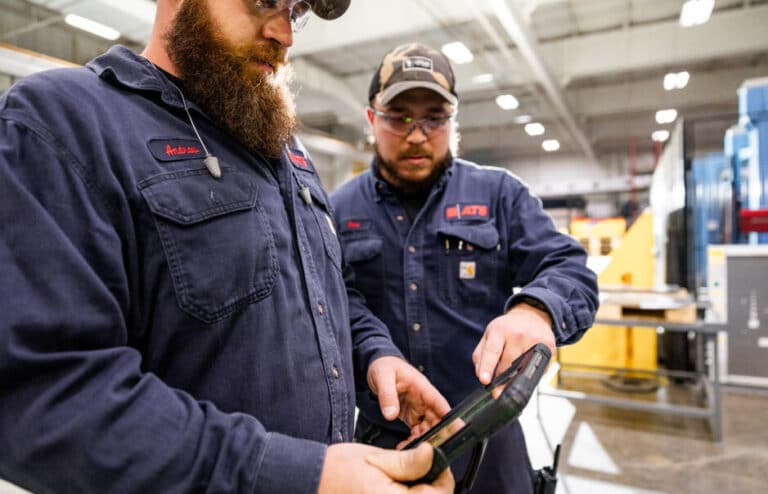The level of increasingly sophisticated analysis made possible by machine learning algorithms and AI has been gradually improving maintenance standards across the industry as a whole. Powerful mathematical models and artificial intelligence algorithms are helping simplify and consolidate the complexities of manufacturing operations, even going so far as being able to predict equipment failures with a surprising 92% accuracy rate!
More and more facilities are embracing the concepts of smart manufacturing and maintenance and integrating machine learning across their entire IIoT (Industrial Internet of Things) infrastructures.
Machine learning is no longer a far-fetched dream but a reality for manufacturing. The practicability of machine learning is even more evident as overall efficiency levels ramp up, disrupting traditional manufacturing as we know it. These incredible new technologies, when integrated across an entire IIoT infrastructure, pave the path toward robust and efficient systems that will undoubtedly define the future of manufacturing and maintenance.
In the next few sections, we’ll discuss condition monitoring AI and machine learning use cases specifically for condition monitoring and look at the types of asset conditions that can be monitored as well as several strategies for monitoring. Let’s dive in!
Value of machine learning for condition-based monitoring
In the world of manufacturing, condition-based monitoring (CBM) is an essential component of operations. It ensures equipment is kept in operational shape which reduces downtime and enhances overall productivity.
When we integrate machine learning into CBM we begin leveraging powerful algorithms that process data, identify patterns and predict potential failures before they can cause a hiccup in operations.
The result is a more effective and efficient system that not only detects issues, but also can suggest remedial action.
Here are some key benefits of employing machine learning in your condition-based monitoring strategy:
- Time Savings: Machine learning can very quickly sift through vast quantities of data and pick up on patterns and trends that human analysts might miss. It can identify the root cause of problems helping your team to address them before they cause significant downtime. This efficiency translates directly into time and cost savings for your operations.
- Decreased Downtime: Downtime is costly in every sense of the word. Production halts, orders get backed up and customers start looking elsewhere for their needs. Machine learning greatly reduces the chance of unexpected downtime by accurately predicting potential failures before they occur.
- Increased Employee Productivity: When your equipment is running smoothly thanks to predictive maintenance, your employees can focus on what they do best rather than getting bogged down with emergency repairs. This leads to a substantial increase in overall productivity.
- Improved Machine Reliability: A machine that’s correctly maintained doesn’t just work better — it lasts longer too. Machine learning can predict and adjust for wear and tear on your machines ensuring they’re always at peak performance levels.
- Early Fault and Failure Detection: A big part of preventing downtime is catching faults before they become failures. Machine learning algorithms are particularly good at this as they can pick up on subtle signs that human operators miss.
Types of asset condition monitoring utilizing machine learning
In the world of asset management and preventative maintenance, machine learning has emerged as a game changer that significantly improves condition monitoring efforts.
Let’s look at several specific applications of machine learning in a few different types of asset condition monitoring AI situations.
Vibration analysis
Vibration analysis is a powerful tool in predictive maintenance capable of diagnosing potential faults in machinery before they lead to catastrophic failures. By using machine learning, the data derived from vibration monitoring can be analyzed in greater detail. These intelligent algorithms can then detect anomalies that may be overlooked by the human eye, resulting in more accurate and timely maintenance recommendations.
Oil analysis
Oil analysis, another critical aspect of asset monitoring, benefits greatly from machine learning applications. The use of artificial intelligence (AI) allows for more in depth analysis of oil conditions including detecting changes in viscosity, contamination and other markers indicative of equipment health. The insights provided by AI in oil analysis can also help in making informed preventive maintenance decisions.
Ultrasonic monitoring
Ultrasonic monitoring is used for advanced leak detection in industrial settings. The power of machine learning comes into play by analyzing ultrasonic waveforms to identify leaks that might go unnoticed otherwise. This level of precision can help guarantee timely maintenance and reduced downtime.
Environmental monitoring
Environmental monitoring is important for maintaining optimal conditions within factories and manufacturing plants. Machine learning allows for the continuous tracking of multiple environmental factors such as humidity, air quality and temperature. Environmental monitoring data is then analyzed providing actionable insights that can improve operations and ensure a safe working environment.
Temperature monitoring
Temperature monitoring is essential for machinery performance and longevity. The integration of machine learning with temperature sensors allows for analyzing temperature data over time and predicting potential overheating scenarios before they occur, allowing preventive measures to be taken effectively.
AI strategies for condition-based monitoring
To keep pace with the rise of technology in our modern industrial world, more and more factories and maintenance professionals are turning their attention to the adoption of AI and machine learning condition monitoring technologies.
Here’s a roadmap for how your organization can incorporate these technologies into condition-based monitoring systems to enhance operational efficiency and preventative maintenance strategies.
1. Use AI to structure and centralize data
Centralizing data is key to effective condition monitoring. Condition monitoring machine learning algorithms can efficiently analyze collected data to provide meaningful insights and identify anomalies, trends and correlations that signal potential problems.
2. Utilize industrial sensors
To gather the data required for condition monitoring, acquiring industrial-grade sensors is the first step. These sensors will then record real-time data on equipment operations such as temperature and vibration to oil/fluid levels. This constant stream of data allows for more informed decision-making and predictive analytics through machine monitoring sensors.
3. Practice reliability-centered maintenance
Reliability-centered maintenance (RCM) is a proactive approach that helps identify failure risks to prioritize monitoring investments. Implementing a reliability-centered maintenance strategy allows for a more efficient approach to maintenance. It focuses on the overall health of an asset rather than routine schedules resulting in improved performance, uptime and reduced unexpected downtime.
4. Digital transformation
The adoption of Industry 4.0/5.0 technologies marks the era of smart factories. With the proliferation of digital integration, factory and maintenance managers need to engage in digital transformation. This includes adopting end to end digital processes for real time maintenance coordination in response to condition-based monitoring alerts.
Concluding thoughts
Implementing artificial intelligence (AI) and machine learning for anomaly detection and condition monitoring can significantly transform the manufacturing landscape by extending the longevity of assets, reducing downtime and optimizing maintenance processes.
By harnessing these technologies industries can improve their efficiency while significantly decreasing their operational costs.
Embracing this innovative approach is no longer just an option — it’s a crucial step for every forward-thinking manufacturer. Contact us today!


